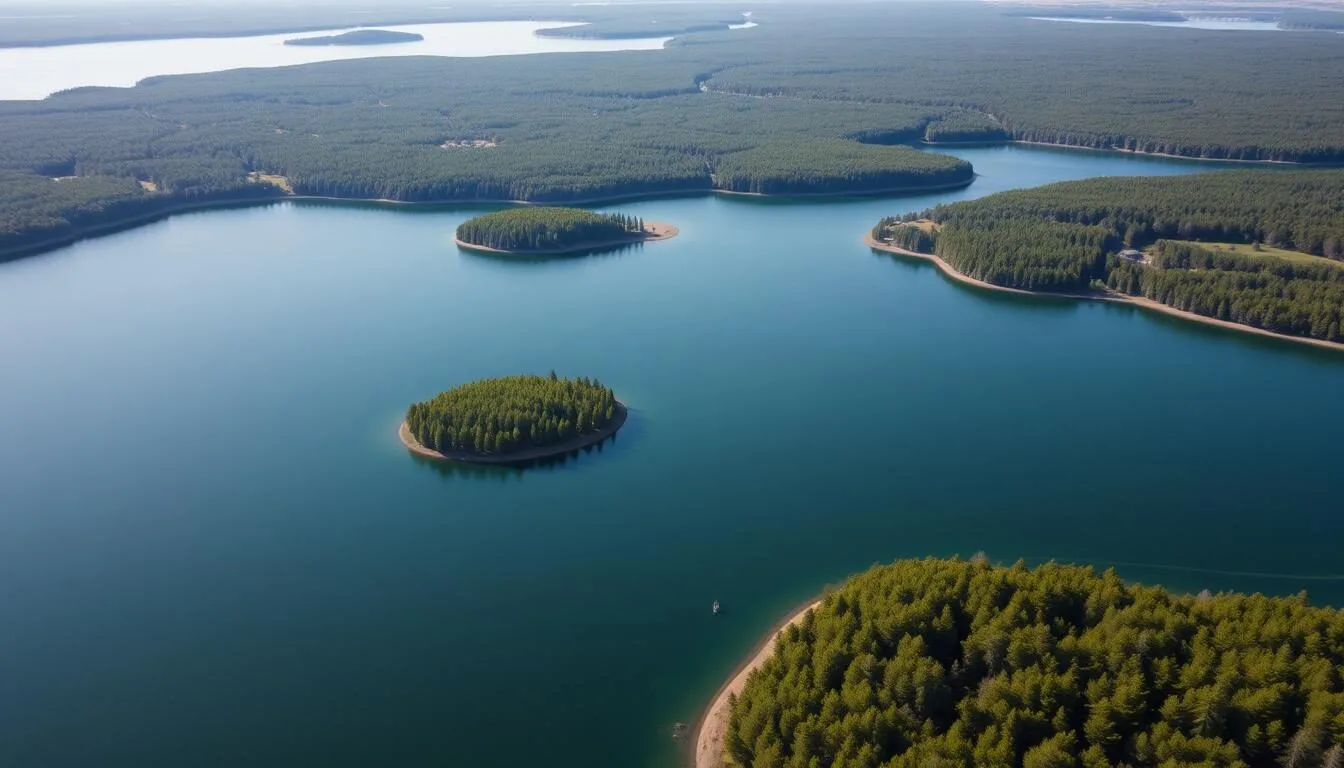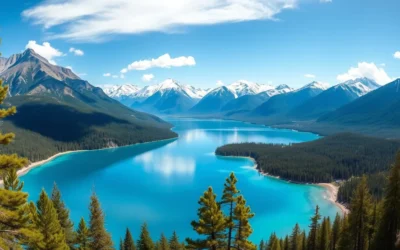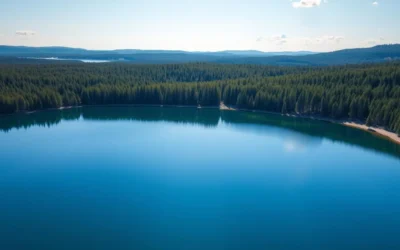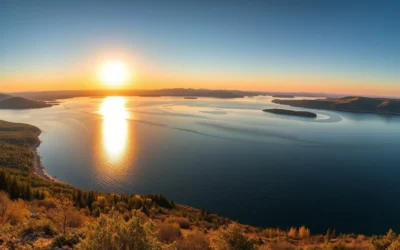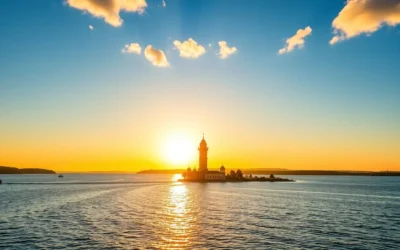Did you know that Lake Gorky isn’t actually a natural lake? This massive 1,591 square kilometer (614 square mile) reservoir was created in the 1950s when the Volga River was dammed to build the Gorky Hydroelectric Station. Today, this sprawling “artificial sea” stretches 430 km (270 miles) through four Russian oblasts, offering visitors a unique blend of natural beauty, Soviet history, and authentic Russian experiences far from the typical tourist path.
Lake Gorky: Russia’s Inland Sea
Known colloquially as the “Gorky Sea,” this massive reservoir was formed between 1955-1957 when the dam of the Gorky Hydroelectric Station (now called Nizhny Novgorod Hydroelectric Station) was built between the towns of Gorodets and Zavolzhye. The reservoir takes its name from the Soviet-era name of Nizhny Novgorod, which was called Gorky during the Soviet period.
Spanning across Yaroslavl, Kostroma, Ivanovo, and Nizhny Novgorod oblasts, Lake Gorky offers diverse landscapes and experiences. While relatively narrow in its upper reaches following the natural Volga riverbed, it expands to an impressive width of 16 km (9.9 miles) downstream of Yuryevets.
Ready to Explore Lake Gorky?
Start planning your Russian adventure with these essential travel services:
Best Time to Visit Lake Gorky

The climate around Lake Gorky follows the typical continental pattern of central Russia, with distinct seasons offering different experiences for visitors.
| Season | Months | Temperature | Activities | Notes |
| Summer | June – August | 20-26°C (68-79°F) | Boating, swimming, fishing, hiking | Peak tourist season, best weather |
| Fall | September – October | 5-15°C (41-59°F) | Photography, hiking, fishing | Beautiful foliage, fewer tourists |
| Winter | November – March | -15 to -5°C (5-23°F) | Ice fishing, winter photography | Reservoir freezes, limited accessibility |
| Spring | April – May | 5-15°C (41-59°F) | Bird watching, fishing, hiking | Melting ice, possible flooding |
Recommended: The best time to visit Lake Gorky is from mid-June to early September when temperatures are pleasant and all water activities are available. May and early October can also be good for those who prefer fewer crowds and don’t mind cooler temperatures.

Getting to Lake Gorky
Lake Gorky is accessible through several entry points across the four oblasts it spans. The most common approaches are:
By Air
The nearest major airports are in Nizhny Novgorod and Yaroslavl. International travelers will likely connect through Moscow before reaching these regional airports.
- Nizhny Novgorod International Airport (GOJ) – 50 km from the southern part of the reservoir
- Yaroslavl Tunoshna Airport (IAR) – 30 km from the northern section
By Train
Russia’s extensive railway network makes train travel a convenient option. Regular services connect Moscow to cities around the reservoir:
- Moscow to Yaroslavl: 4 hours
- Moscow to Kostroma: 5-6 hours
- Moscow to Nizhny Novgorod: 4 hours (high-speed Sapsan train)

By Car
Driving gives you the most flexibility to explore different parts of the reservoir. Major highways connect Moscow to the cities surrounding Lake Gorky:
- Moscow to Yaroslavl: 4-5 hours via M8 highway
- Moscow to Nizhny Novgorod: 5-6 hours via M7 highway
- Nizhny Novgorod to Kineshma (mid-point of reservoir): 3 hours
Top Things to Do at Lake Gorky

Water Activities
Boating & Cruises
Explore the vast reservoir by boat, from short excursions to multi-day cruises. Several operators offer tours that stop at historic towns along the shores. Boat rentals are available in larger settlements like Kineshma and Yuryevets.
Fishing
Lake Gorky is famous for its fishing opportunities, with abundant pike, perch, bream, and catfish. Local guides can take you to the best spots, and ice fishing is popular during winter months when the reservoir freezes over.
Swimming & Beaches
During summer months, numerous beaches along the reservoir offer swimming opportunities. The most developed beaches are near larger settlements, with some featuring amenities like changing cabins and food vendors.

Historical & Cultural Attractions
Yuryevets
This historic town was partially relocated when the reservoir was filled. Visit the Yuryevets History Museum to learn about the town’s past and the creation of the reservoir. The town is also known for its connection to famous film director Andrei Tarkovsky.
Kineshma
A picturesque town on the right bank of the reservoir with well-preserved 19th-century architecture. The Church of the Ascension offers beautiful views of Lake Gorky from its hilltop location.
Plyos
Though technically on the Volga River just before it enters the reservoir, this charming town is famous for inspiring landscape painter Isaac Levitan. The Levitan Museum and numerous viewpoints make it a must-visit.

Explore Lake Gorky’s Attractions
Discover guided tours and activities around Lake Gorky and nearby cities.
Where to Stay Around Lake Gorky
Accommodation options around Lake Gorky range from city hotels to countryside guesthouses and rustic fishing lodges. Here are the best areas to stay based on your interests:

Nizhny Novgorod
The largest city near the reservoir offers the widest range of accommodations, from international hotel chains to boutique hotels. Stay here if you want urban amenities and day trips to the southern part of the reservoir.
Kineshma & Yuryevets
These mid-sized towns offer a good balance of amenities and proximity to the water. Several small hotels and guesthouses provide comfortable accommodation with authentic local character.
Fishing Bases & Countryside Lodges
For nature lovers and fishing enthusiasts, numerous specialized lodges are scattered along the shores. These range from basic cabins to comfortable resorts with saunas and restaurants.
Find Your Perfect Stay
Browse accommodations around Lake Gorky to suit every budget and preference.
Practical Travel Tips

Language
English is not widely spoken outside major cities. Learning basic Russian phrases will be helpful, especially in smaller towns around the reservoir. Consider downloading a translation app that works offline.
Transportation
Public transportation between towns is limited. Renting a car is recommended for flexibility. Alternatively, river transport connects some settlements during summer months.
Weather Preparedness
Weather can change quickly, especially on the water. Pack layers even in summer, and bring proper winter gear if visiting during colder months. Waterproof clothing is recommended year-round.
“Lake Gorky offers a glimpse into authentic Russian life away from the tourist crowds. The hospitality of locals and the pristine natural settings make it worth venturing beyond the typical Moscow-St. Petersburg route.”

Safety & Etiquette
- Register with local authorities if staying in private accommodations (your host will usually handle this)
- Swimming is safe in designated areas, but be cautious of currents in wider parts of the reservoir
- Fishing requires permits for certain species and seasons
- When visiting churches or monasteries, dress modestly (shoulders and knees covered)
- It’s customary to remove shoes when entering someone’s home

Experience the Hidden Gem of Lake Gorky
Lake Gorky offers a unique opportunity to experience Russia beyond the familiar tourist destinations. From its fascinating Soviet-era history to the natural beauty of its vast waters and forested shores, this massive reservoir rewards travelers willing to venture off the beaten path.
Whether you’re casting a line for the reservoir’s prized fish, exploring historic towns that were partially submerged during its creation, or simply enjoying a sunset cruise on its expansive waters, Lake Gorky provides authentic experiences that connect you with both Russia’s past and present.
Ready to Discover Lake Gorky?
Start planning your Russian adventure today with these essential travel services:
The above is subject to change.
Check back often to TRAVEL.COM for the latest travel tips and deals.
